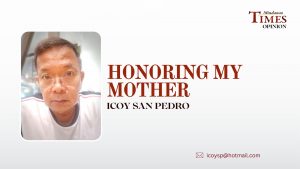The old Davao, with its quaint and narrow streets and side streets, is now only revisited either thru old-timers’ grainy memories and a few faded photographs which museums and old residents may have kept in old albums or archives. With luck, most of these could still surely be in glossy black and whites or muddy sepias.
As for me, one of my earliest memories of our hometown is standing in the middle of San Pedro Street with my Lolo Ute at dusk, waiting for a kalesa go past, before we could finally cross to the other side of the street. We had then proceeded to a popular soda fountain at the time called Three Sisters, which was aptly owned by, you guessed it, three huge ladies, who greeted us warmly at the entrance.
San Pedro street back then was so unlike today. As I recall (and I don’t trust my memory that much anymore), it was muddy and quite narrow unlike today. It may have passed for a one lane street back then, except for the fact that it was indeed two-way where, horse-drawn carts or kalesas competed with a few Oldsmobiles that plied through it in the day.
I place that visit at the time I was in grade 4, and a week before the big fire of 1964 which raged for almost a day and razed most of that main street, sparing only the cathedral, which was then still called San Pedro church. That must have been a Phoenix rising from the ashes moment for the city because right after that infamous incident, Davao began to change by leaps and bounds. True, while other main streets like Claveria and Uyanguren still had a few ancient houses by the road, almost right away, much-improved sidewalks and new buildings rose to become the face of the 70s onward.
It was on these present-day sidewalks and edifices where there likewise sprung forth notable street characters who provided the starkest contrasts to all our city’s semblance of modernity.
In my early college days, a scruffy woman in rags walked the streets cursing loudly at those who teased and called her “Pancit”, a play on words for her real name, Pacita. In other places, one might call her a bag lady, for the many Knick knacks she carried on her person. The only times she appeared lucid and at peace would be whenever one found her at the cathedral steps, singing softly a little tune I think she herself made up.
Another unforgettable street character is one they fondly called Rambo . This was a long-haired guy, sometimes with a bandana or a thin piece of rope wrapped round his head, making him appear like an Apache indian. Well-built and naked from the waist up, he often has a bow and arrows slung from his shoulders. A more quiet personality, he is often seen walking, always counter flow, along the middle lines of the city roads and highways, looking just straight ahead, oblivious to the heckles of motorists and passers-by.
By the 80s, who knows where these two have gone to. The last time I might have thought I have seen Rambo, I was on a bus and I heard someone shout out his name. When I finally looked in his direction, all I caught was the sight of a fleeing figure disappearing in the traffic. As for Pacita, I passed by her slumped figure in an alley one day, clearly with child, sobbing and humming softly a religious chant I like to believe to be own.
Although, I have never seen them ever again, I cannot help but look at all that has changed with Davao, without also remembering their faces, though now sepia in my mind. Their images, however blurry at times, are nevertheless always meshed with my recollections of kalesas on muddy streets.



